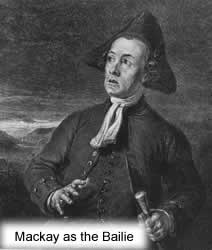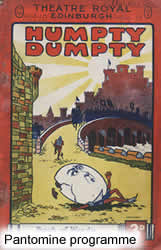|
|
 |
Edinburgh’s Theatre Royal - A History
| The foundation stone
of the Theatre Royal was laid on 16 March 1768 and it opened on 9
December 1769, an occasion commemorated in verse by James Boswell.
Built in Shakespere Square, an area at the east end of Princes’ Street,
the building was to be in use as a theatre for ninety years. During
that time, the theatre was at the centre of some of the most important
developments in Scottish cultural life. |
 |
 |
For the first forty years of its life,
the theatre made little impact. Two centuries of Kirk opposition to
the theatre, in various degrees of severity, coupled with an intrusive
government censor, imposed major limitations on what could be staged
in Edinburgh. The arrival of Sir Walter Scott transformed the situation.
Scott was a patron and outspoken friend of the drama (as a young advocate,
in 1794, he fought in a riot at the Theatre Royal sparked off when
some members of the audience refused to stand for the National Anthem).
More importantly, Scott’s historical novels offered new possibilities
for adaptation to the theatre. A play that was unambiguously about
the modern political situation in Scotland would have been heavily
censored, but a play based on a novel about the Jacobite risings could
escape censorship on the grounds that it was just based on fiction.
This allowed for the possibility of a national drama that could reflect
on Scotland through the medium of literature. |
| The Theatre
Royal benefited in this period from having good managers. The actors
Henry and Sarah Siddons led the theatre from 1809 until Henry’s death
in 1815, and thereafter it was run by his wife and her brother William
Murray, Murray remaining in charge until 1851. It was under Murray,
in 1819, that the astonishing success of the stage adaptation of Scott’s
Rob Roy made the theatre relatively rich. With Charles (‘the real’)
Mackay playing Bailie Nicol Jarvie, this good-humoured adaptation
saw Scotland starting to come to terms with its history of civil war
and social division. When George IV visited Edinburgh in 1822, he
ordered a performance of Rob Roy at the Theatre Royal, which took
place on August 27, 1822. It was a triumphant success and placed the
Theatre Royal at the centre of the Scottish cultural revival. |
 |
 |
After Murray’s retirement in 1851, the theatre fell on harder times,
and the railway network encouraged a drain of talent to London.
Scott was not followed by a host of keen new Scottish writers, and
the theatre had to rely on endless revivals of the Waverley novels.
In 1859, the government purchased the old Theatre Royal building
to make way for the Post Office. Although several new Theatre Royals
were to be built in Edinburgh, its golden age ended with the closure
of the old premises on May 25, 1859.
The National Library of Scotland is fortunate to have a very good
collection of playbills advertising performances and events at the
Theatre Royal, from 1807 to 1851, bound in chronological order.
The collector – currently not identified – frequently writes on
the playbills which shows he/she saw, who else was there and how
much he/she paid for entry.
|
|
Playbills were printed on one side of a sheet of paper so they
could easily be stuck up on a wall. Normally, they carried details
of the main performance, the names of the star actors, and the title
of any sub-performances or songs to follow the main show. Modern
ideas of a night out at the theatre do not correspond to the events
on offer at the Theatre Royal, which ranged from performances of
Macbeth to lectures on astronomy, and from musical comedies to military
bands.
We have digitised a selection of our early playbills, starting
from 1807, omitting only damaged and near-duplicate copies, to give
a picture of the activities of Scotland’s leading theatre in the
early nineteenth century. To find other playbills in the National
Library’s collections, there is a paper sheaf catalogue available
in the National Library’s building on the George IV Bridge, Edinburgh.
|
 |
| For further reading,
see particularly Findlay, Bill (ed.), A History of Scottish Theatre,
Edinburgh, 1998 and Dibdin, James C. Annals of the Edinburgh Stage,
Edinburgh, 1888. |
|





